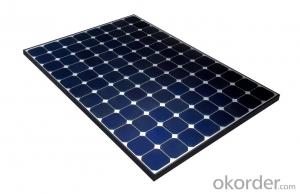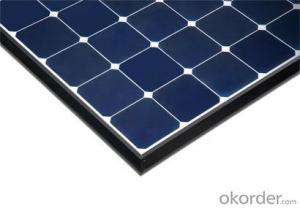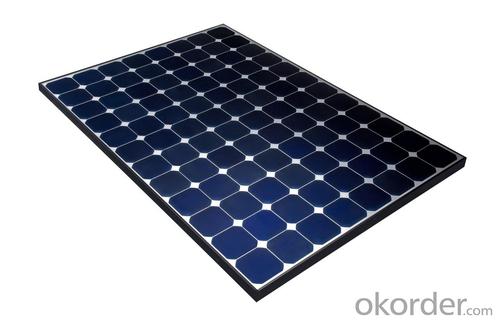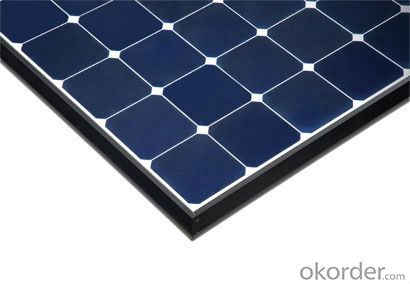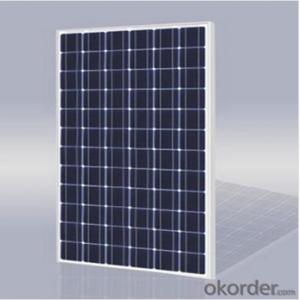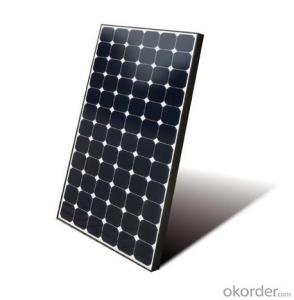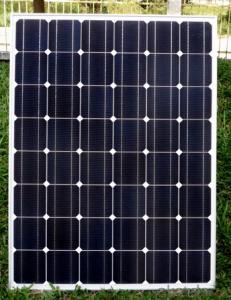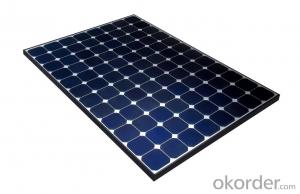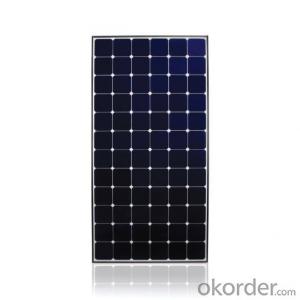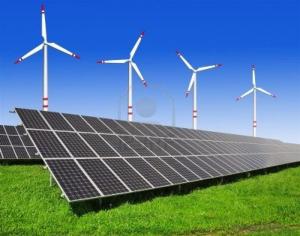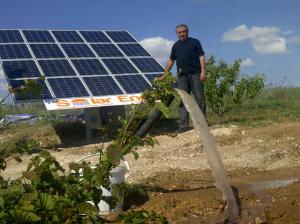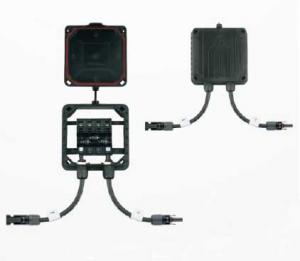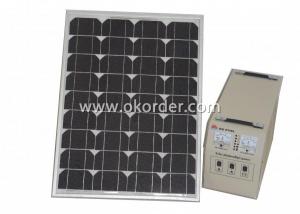500kw CNBM Industrial Solar Energy Systems Monocrystalline Silicon Panel for Home Use
- Loading Port:
- Shekou
- Payment Terms:
- TT OR LC
- Min Order Qty:
- 100 watt
- Supply Capability:
- 1000 watt/month
OKorder Service Pledge
OKorder Financial Service
You Might Also Like
Specification
500KW CNBM Monocrystalline Silicon Panel for Home Using
Production description
Solar power is the conversion of sunlight into electricity, either directly using photovoltaics (PV), or indirectly using concentrated solar power (CSP). Concentrated solar power systems use lenses or mirrors and tracking systems to focus a large area of sunlight into a small beam. Photovoltaics convert light into anelectric current using the photovoltaic effect.[1]
The International Energy Agency projected in 2014 that under its "high renewables" scenario, by 2050, solar photovoltaics and concentrated solar power would contribute about 16 and 11 percent, respectively, of theworldwide electricity consumption, and solar would be the world's largest source of electricity. Most solar installations would be in China and India.[2]
Solar energy is radiant light and heat from the Sun harnessed using a range of ever-evolving technologies such assolar heating, photovoltaics, solar thermal energy, solar architecture and artificial photosynthesis.
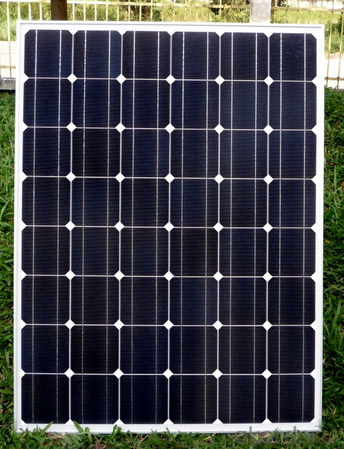
Feature
1.High conversion efficiencies resulting in superior power output performance.
2.Outstanding power output even in low light or high temperature conditions
3.Optimized design for ease of soldering and lamination
Physical characteristic
1. Rigorous quality control meets the highest international standards.
2. High-transmissivity low-iron tempered glass, strong aluminium frame.
3. Using UV-resistant silicon.
4. IS09001/14001/CE/TUV/UL
packaging
26pcs in one carton 6pallets in 20foot container 14pallets in 40 foot container.
- Q: Can solar energy systems be used in remote areas?
- Yes, solar energy systems can be used in remote areas. Solar power is a versatile and sustainable energy source that can be harnessed virtually anywhere as long as there is sunlight. It is particularly beneficial in remote areas that lack access to traditional power grids as it can provide a reliable and independent source of electricity. The advancements in solar technology and the decreasing costs of solar panels have made it more accessible and feasible for remote communities to adopt solar energy systems for their energy needs.
- Q: Can solar energy systems be installed on religious institutions?
- Yes, solar energy systems can certainly be installed on religious institutions. In fact, many religious institutions have embraced the use of solar energy as a sustainable and environmentally friendly alternative to traditional energy sources. Installing solar panels on religious institutions not only helps them reduce their carbon footprint and save money on energy bills but also serves as a positive example of stewardship and responsible resource management for their communities.
- Q: What are the environmental benefits of using solar energy systems?
- There are several environmental benefits associated with using solar energy systems. Firstly, solar energy is a renewable source of energy, meaning it is constantly replenished by the sun and will never run out. This is in stark contrast to fossil fuels like coal or oil, which are finite resources and contribute to the depletion of our planet's natural resources. Another significant environmental benefit of solar energy is its minimal greenhouse gas emissions. When compared to traditional energy sources like coal or natural gas, solar energy systems produce significantly lower levels of carbon dioxide and other harmful pollutants. By reducing our reliance on fossil fuels and transitioning to solar power, we can mitigate the adverse effects of climate change and improve air quality. Furthermore, solar energy systems have a smaller ecological footprint compared to other forms of energy generation. The extraction and transportation of fossil fuels often leads to habitat destruction, soil erosion, and water pollution. On the other hand, solar panels have a relatively low impact on the environment during their manufacturing process, and they do not require ongoing extraction or transportation of fuel. Solar energy systems also offer the advantage of decentralization. Unlike large-scale power plants that rely on extensive transmission infrastructure, solar panels can be installed on rooftops, reducing the need for long-distance energy transportation. This not only decreases the energy loss during transmission but also helps to protect natural habitats from being disrupted by the construction of power lines. Finally, using solar energy systems can contribute to energy independence. By harnessing the power of the sun, individuals, communities, and even entire countries can reduce their reliance on imported energy resources. This reduces the vulnerability to price fluctuations and supply disruptions associated with fossil fuels, promoting energy security and stability. In conclusion, the environmental benefits of using solar energy systems are numerous and significant. From being a renewable source of energy and reducing greenhouse gas emissions to minimizing ecological footprints and promoting energy independence, solar power offers a sustainable and responsible alternative to traditional energy sources.
- Q: Can a solar energy system be installed on a hospital or healthcare facility?
- Yes, absolutely. Solar energy systems can be installed on hospitals or healthcare facilities. In fact, many hospitals and healthcare facilities are adopting solar energy as a sustainable and cost-effective solution to meet their energy needs. These systems can provide clean and renewable energy, reducing the facility's carbon footprint and operating costs. Additionally, solar energy installations can help hospitals maintain a reliable power supply during emergencies or power outages, ensuring uninterrupted patient care.
- Q: How do solar batteries store excess energy?
- Solar batteries store excess energy by converting the surplus electricity generated by the solar panels into chemical energy. This chemical energy is stored in the battery in the form of charged ions, which can be released as electrical energy when needed, such as during periods of low sunlight or high energy demand.
- Q: What is the impact of snow cover on the performance of solar panels?
- The performance of solar panels can be affected by snow cover, which depends on factors such as the severity and duration of the snowfall, as well as the design and tilt angle of the panels. When snow covers solar panels, their ability to generate electricity is hindered. The snow blocks the sunlight from reaching the panel's surface, resulting in a decrease in the amount of energy that can be converted. As a result, the overall power output of the solar system during the snowy period may decrease. However, it is important to note that most solar panels are designed with a tilt angle that allows for natural shedding of snow. By installing the panels at an angle, the snow can slide off more easily, exposing the surface to sunlight once again. In areas with regular snowfall, solar panel installations often have a steeper tilt angle to facilitate snow removal. Additionally, some solar panels are equipped with anti-reflective coatings or self-cleaning features that can minimize the impact of snow cover. These coatings or features prevent snow from sticking to the surface, enabling faster snow removal and improved performance. It is worth mentioning that snow cover can have a positive effect on solar panels in certain situations. A thin layer of snow can act as insulation, helping to retain heat and potentially increasing the efficiency of the panels. However, this effect is generally minimal and applicable only under specific conditions. Overall, while snow cover can temporarily reduce the performance of solar panels, its impact can be alleviated through proper installation techniques and design considerations. In areas with regular snowfall, it is important to consider the tilt angle, anti-reflective coatings, and self-cleaning features to ensure optimal performance throughout the year.
- Q: Can solar energy systems be used for emergency backup power?
- Yes, solar energy systems can be used for emergency backup power. Solar panels can generate electricity during daylight hours and store excess power in batteries for use during emergencies or when the grid goes down. This provides a reliable and sustainable source of backup power in situations where traditional power sources may not be available.
- Q: Can solar energy systems be used in areas with high levels of poverty?
- Yes, solar energy systems can be used in areas with high levels of poverty. In fact, solar energy is often considered a viable solution for providing affordable and sustainable electricity to underserved communities. Solar power can reduce reliance on traditional energy sources, lower energy costs, and provide a reliable source of electricity even in remote areas. Additionally, solar energy systems can be implemented on a small-scale basis, allowing individuals and communities to gradually adopt this renewable energy source according to their needs and financial capabilities. Overall, solar energy has the potential to greatly benefit areas with high levels of poverty, promoting economic development and improving living conditions.
- Q: How much space do I need for a solar energy system?
- The amount of space needed for a solar energy system depends on various factors such as the size and efficiency of the solar panels, the electricity consumption of the household, and the geographical location. On average, a residential solar system requires around 100-400 square feet of unobstructed roof space per kilowatt of installed capacity. It is best to consult with a professional solar installer who can assess your specific needs and provide accurate space requirements for your solar energy system.
- Q: Can solar energy systems be used to power remote locations?
- Yes, solar energy systems can definitely be used to power remote locations. In fact, solar energy is particularly well-suited for remote applications where access to the conventional power grid may be limited or non-existent. Solar panels can be installed in remote areas that receive adequate sunlight, allowing for the generation of electricity even in off-grid locations. Solar energy systems for remote locations typically consist of photovoltaic (PV) panels, which convert sunlight into electricity, and a battery storage system to store excess energy for use during non-sunlight hours. In this way, solar energy can provide a reliable and continuous power supply even in areas without access to the grid. Remote locations such as rural communities, remote research facilities, off-grid cabins, and telecommunications towers can benefit greatly from solar energy systems. They offer a sustainable and renewable source of energy, reducing reliance on fossil fuels and reducing environmental impact. Additionally, solar energy systems require minimal maintenance and are cost-effective in the long run, making them an ideal solution for powering remote locations.
Send your message to us
500kw CNBM Industrial Solar Energy Systems Monocrystalline Silicon Panel for Home Use
- Loading Port:
- Shekou
- Payment Terms:
- TT OR LC
- Min Order Qty:
- 100 watt
- Supply Capability:
- 1000 watt/month
OKorder Service Pledge
OKorder Financial Service
Similar products
Hot products
Hot Searches
Related keywords
